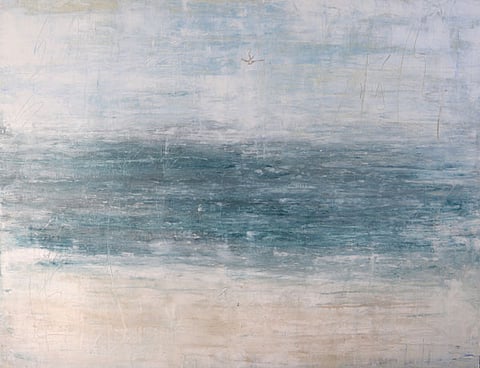ROGER KÖNIG: Brings Antique Techniques To Contemporary Art
Tell us how you came to art.
During my master craftsman training I used to restore ancient churches. As a result, I acquired a lot of knowledge in the field of old painting techniques. These included frescoing, marble painting, maceration and the processing of natural clay colors. I love matte and textured surfaces, warm colors and patina effects. My grandfather was an art collector and so the idea came up to combine old and traditional painting techniques with contemporary art. It creates beautiful color gradients. The natural clay color gives the pictures a very special texture, which stands in exciting contrast to the delicate gloss of the acrylic paint. The properties of the clay color allow a more intensive treatment of the surface. I have spent many years trying to find the right composition of colors.
Where did you go to college?
I received my master's degree as a painter and varnisher in 1994 at the HWK Halle (Germany). Afterwards, I studied Innovation Management at the University of Applied Sciences Magdeburg.
What are your inspirations?
That's a good question, and to be honest, I can not always say exactly what inspired me directly. I like to store motives or pictures that calm me down. I like natural, earthy and warm colors and matte surfaces. I want to radiate peace with my art. The world is very hectic and the internet gives us daily information and stimuli to process. Since a "Ruhepol" is very important. My artworks will take 4-6 weeks to complete. There are many layers of paint applied. The pictures grow like "children" until they grow up.
Which form of painting would you say is your art?
Not only do I not work objectively, I also include figurative elements in my paintings. My portraits and representations of figures bridge the gap between abstraction and figuration. Elements of nature, such as beaches, lakes or oceans can also be identified. However, they remain vague due to the abstract nature of the painting and have to be read like universal codes. Also in this case, it is up to the viewer, what he or she wants to see. In each moment, new things can be discovered in the image, it changes its meaning: depending on light, time of day or personal mood.
Who are your customers? Have you already done many art shows?
My customers/art collectors are mainly from the USA and Germany. I have works in private
collections in Chicago, New York, Los Angeles, Texas as well as in Berlin, Leipzig and Munich. I regularly take part in national art fairs in Germany (Cologne and Leipzig).
What's your next series?
At the moment I am working on a "Beach Series." I try to show the most beautiful beaches in my abstract way, such as the "1272 Abstract Siesta Beach."
Which series are you most proud of ?
I am particularly proud of the series "Abstract Girl in the Rain." It is a fascinating motif and presented beautifully with the blurred painting technique.
Which artists inspire you the most?
There are many outstanding artists who paint very beautiful works of art. I love, for example, art of Rothko. He was an American painter of Abstract Expressionism and a pioneer of color field experiments.
Inspired by what you read?
Get more stories like this—plus exclusive guides and resident recommendations—delivered to your inbox. Subscribe to our exclusive newsletter
Resident may include affiliate links or sponsored content in our features. These partnerships support our publication and allow us to continue sharing stories and recommendations with our readers.

